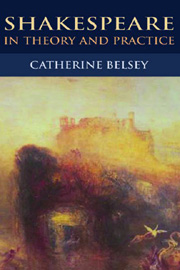Book contents
- Frontmatter
- Contents
- Preface
- 1 Introduction: Practising with Theory
- 2 Psychoanalysis and Early Modern Culture: Lacan with Augustine and Montaigne
- 3 Love as Trompe-l'oeil: Taxonomies of Desire in Venus and Adonis
- 4 Tarquin Dispossessed: Expropriation and Consent in The Rape of Lucrece
- 5 Antinomies of Desire and the Sonnets
- 6 Peter Quince's Ballad: Memory, Psychoanalysis, History and A Midsummer Night's Dream
- 7 The Illusion of Empire: Elizabethan Expansionism and Shakespeare's Second Tetralogy
- 8 Making Histories Then and Now: Shakespeare from Richard II to Henry V
- 9 The Case of Hamlet's Conscience
- 10 Iago the Essayist
- Notes
- Index
5 - Antinomies of Desire and the Sonnets
Published online by Cambridge University Press: 12 September 2012
- Frontmatter
- Contents
- Preface
- 1 Introduction: Practising with Theory
- 2 Psychoanalysis and Early Modern Culture: Lacan with Augustine and Montaigne
- 3 Love as Trompe-l'oeil: Taxonomies of Desire in Venus and Adonis
- 4 Tarquin Dispossessed: Expropriation and Consent in The Rape of Lucrece
- 5 Antinomies of Desire and the Sonnets
- 6 Peter Quince's Ballad: Memory, Psychoanalysis, History and A Midsummer Night's Dream
- 7 The Illusion of Empire: Elizabethan Expansionism and Shakespeare's Second Tetralogy
- 8 Making Histories Then and Now: Shakespeare from Richard II to Henry V
- 9 The Case of Hamlet's Conscience
- 10 Iago the Essayist
- Notes
- Index
Summary
To desire in Shakespeare's Sonnets is also to fight. Whatever we set out to find in these poems – the inscription of love, a historical narrative, or a sexual identity – antagonism clearly inhabits the passion they portray. Projected outwards, this hostility is variously directed at time, death, nature and a rival poet, but its objects also include the addressees, as well as poetry itself.
Very little else about the Sonnets is as clear-cut. Individually, they are admired as if their meanings were self-evident: specific sonnets have been variously anthologised, read out at weddings, recited in Shakespeare in Love and quoted in Dr Who. Read consecutively, on the other hand, they withhold almost as much as they deliver. There is no way to be sure whether they form a sequence addressed to two people, a fair young man and a dark woman, or a collection, written at intervals to various people and not bound together until their publication in 1609. The order and numbering cannot confidently be ascribed to the author. Were they composed mainly in the 1590s, at the height of the sonnet vogue in England, or later, to rewrite with a difference the conventions that vogue might be thought to have exhausted? Are they fact, based on personal experience, or fiction, an exploration by a dramatist of new possibilities for an old genre? And does that distinction between fact and fiction hold when it comes to love? Doesn't any sexual relationship exist as much in the distinct imaginations of each lover as in the exchanges of the couple?
- Type
- Chapter
- Information
- Shakespeare in Theory and Practice , pp. 73 - 93Publisher: Edinburgh University PressPrint publication year: 2008



